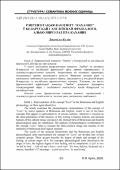| dc.contributor.author | Кулік, Л. | |
| dc.coverage.spatial | Кривий Ріг | ru_RU |
| dc.date.accessioned | 2024-08-13T13:09:42Z | |
| dc.date.available | 2024-08-13T13:09:42Z | |
| dc.date.issued | 2020 | |
| dc.identifier.citation | Кулік, Л. Рэпрэзентацыя канцэпту “каханне” ў беларускай і англійскай фразеалогіі, альбо Яшчэ раз пра каханне / Л. Кулік // Філологіка= Philologica : зб. наук. праць / за ред. Ж. Колоїз. — Кривий Ріг : ФОП Маринченко С. В., 2020. — Вип. 21. — С. 33—43. | ru_RU |
| dc.identifier.uri | https://elib.gstu.by/handle/220612/37257 | |
| dc.description.abstract | У статті досліджено репрезентацію концепту “Любов” на матеріалі
білоруської та англійської фразеології крізь призму порівняльного й
лінгвокультурологічного аспектів. Акцентовано на основних параметрах
інтенсивності прояву відповідного почуття. Виявлено загальні риси та
національні особливості культурного образу, закодованого у внутрішній формі
білоруських та англійських фразеологічних одиниць. З’ясовано, що аналіз
фразеологічної вербалізації концепту “Любов” допомагає відтворити
етнокультурний образ і особливості менталітету носіїв білоруської та
англійської мов. | ru_RU |
| dc.description.abstract | The article examines the phraseological representation of the concept of
“Love” by native speakers of Belarusian and English, which is one of the basic
concepts that appear in representatives of various cultures. Attention is focused on
the main parameters of the intensity of this feeling. Common features and national
features of the cultural image encoded in the internal form of Belarusian and English
phraseological units are established. The analysis of phraseological verbalization of
the concept “Love” helps to recreate the ethnocultural image and features of the
mentality of Belarusian and English speakers.
The results of the research demonstrate that the Belarusian and English
phraseological units representated the concept of “Love” are divided into several
semantic groups. These groups describe the degree of depth and strength of the
feeling, or certain stages of it. For example, phraseological units characterize the
origin of love, the highest degree of this feeling, and its completion: to fall in love
‘to fall in love’ – with all one’s heart <and soul> ‘(to love, believe, be proud, etc.)
sincere, heartfelt)’ (1st meaning) – to fall out of love ‘to stop loving’.
Linguistic meaning and cultural content of the phraseological units cause
their special role in the speaking – to characterize the person’s attitude to the feeling
of love and pay attention to the different ways of their display. The national-cultural
interpretation of the concept “Love” in phraseology of native speakers of Belarusian
and English shows that to imagine the part of their language picture of the world
could be exactly through the description of the stereotypes in the inner form of the
phraseological units. The conclusions of the article can be used in giving courses in
the field of phraseology, cultural linguistics, inter-language communication, theory
and practice of translation and compiling of phraseological dictionaries. | |
| dc.language.iso | by | ru_RU |
| dc.publisher | Криворізький державний педагогічний університет | ru_RU |
| dc.subject | Фразеологічна одиниця | ru_RU |
| dc.subject | Концепт | ru_RU |
| dc.subject | Порівняльний аспект | ru_RU |
| dc.subject | Лінгвокультурологічний аспект | ru_RU |
| dc.subject | Загальні риси | ru_RU |
| dc.subject | Національні особливості | ru_RU |
| dc.subject | Phraseological unit | ru_RU |
| dc.subject | Concept | ru_RU |
| dc.subject | Comparative aspect | ru_RU |
| dc.subject | Linguacultural aspect | ru_RU |
| dc.subject | Common features | ru_RU |
| dc.subject | National peculiarities | ru_RU |
| dc.title | Рэпрэзентацыя канцэпту “каханне” ў беларускай і англійскай фразеалогіі, альбо Яшчэ раз пра каханне | ru_RU |
| dc.title.alternative | Representation of the concept “Love” in the Belarusian and English phraseology, or Once again about love | ru_RU |
| dc.title.alternative | Репрезентація концепту “Любов” у білоруській та англійській фразеології, або Ще раз про кохання | ru_RU |
| dc.type | Article | ru_RU |
| dc.identifier.udc | [811.161.3+811.111]'373.7:177.6 | |
| local.identifier.doi | 10.31812/filstd.v21i.4751 | |
